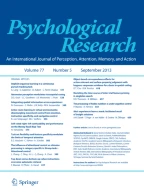Abstract
Effects of semantic processing of crowded characters were investigated using numbers as stimuli. In an identification task, typical spacing effects in crowding were replicated. Using the same stimuli in a magnitude comparison task, a smaller effect of spacing was observed as well as an effect of response congruency. These effects were replicated in a second experiment with varying stimulus-onset asynchronies. In addition, decreasing performance with increasing onset-asynchrony (so-called type-B masking) for incongruent flankers indicates semantic processing of target and flankers. The data show that semantic processing takes place even in crowded stimuli. This argues strongly against common accounts of crowding in terms of early stimulus-driven impairments of processing.
Similar content being viewed by others
References
Besner, D., & Coltheart, M. (1979). Ideographic and alphabetic processing in skilled reading of English. Neuropsychologia, 17, 467–472.
Bonneh, Y., & Sagi, D. (1998). Effects of spatial configuration on contrast detection. Vision Research, 38, 3541–3553.
Bonneh, Y., & Sagi, D. (1999). Configuration saliency revealed in short duration binocular rivalry. Vision Research, 39, 271–281.
Bouma, H. (1970). Interaction effects in parafoveal letter recognition. Nature, 226, 177–178.
Cavanagh, P. (2001). Seeing the forest but not the trees. Nature Neuroscice, 4(7), 673–674.
Dehaene, S., & Akhavein, R. (1995). Attention, automaticity, and levels of representation in number processing. Journal of Experimental Psychology. Learning, Memory, and Cognition, 21, 314–325.
Dehaene, S., Bossini, S., & Graux, P. (1993). The mental representation of parity and numerical magnitude. Journal of Experimental Psychology. General, 122, 371–396.
DiLollo, V., Enns, J. T., & Rensink, R. A. (2000). Competition for consciousness among visual events: the psychophysics of reentrant visual processes. Journal of Experimental Psychology. General, 129, 481–507.
Eriksen, B. A., & Eriksen, C. W. (1974). Effects of noise letters upon the identification of a target letter in a nonsearch task. Perception and Psychophysics, 16, 143–149.
Estes, W. K. (1982). Similarity-related channel interactions in visual processing. JEP HPP, 8, 353–382.
Feigensohn, L., Dehaene, S., & Spelke, E. (2004). Core systems of number. Trends in Cognitive Sciences, 8, 307–314.
Francis, G., & Herzog, M. H. (2004). Testing quantitative models of backward masking. Psychological Bulletin Review, 11, 104–112.
He, S., Cavanagh, P., & Intrilligator, J. (1996). Attentional resolution and the locus of visual awareness. Nature, 383, 334–337.
Huckauf, A. (2006). Task set determines the amount of crowding. Psychological Research, 23 May 2006 [Epub].
Huckauf, A., & Heller, D. (2004). On the relations between crowding and visual masking. Perception and Psychophysics, 66, 584–595.
Huckauf, A., Heller, D., & Nazir, T.A. (1999). Lateral masking: some limitations of the feature interaction account. Perception and Psychophysics, 61, 177–189.
Huynh, H., & Feldt, L. S. (1970). Estimation of the box correction for degrees of freedom from sample data in randomized block and split-block designs. Journal of Educational Statistics, 1, 69–82.
Moyer, R. S., & Landauer, T. K. (1967). Time required for judgements of numerical inequality. Nature, 215, 1519–1520.
Nuerk, H.-C., Bauer, F., Krummenacher, J., Heller, D., & Willmes, K. (2005). The power of the mental number line: how the magnitude of unattended numbers affects performance in an Eriksen task. Psychology Science, 47(1), 34–50.
Pelli, D. G., Palomares, M., & Majaj, N. J. (2004). Crowding is unlike ordinary masking: distinguishing feature detection and integration. Journal of Vision, 4, 1136–1169.
Shapiro, L. E., & Krueger, L. E. (1983). Effects of similarity of surround on target-letter processing. Journal of Experimental Psychology HPP, 9, 547–549.
Styles, E. A., & Allport, D. A. (1986). Perceptual intergration of identity, location and colour. Psychological Research, 48, 189–200.
Treisman, A. M., & Gelade, G. (1980). A feature integration theory of attention. Cognitive Psychology, 12, 97–136.
Wolford, G. (1975). Perturbation model for letter identification. Psychological Review, 82, 184–199.
Acknowledgments
We thank Frank Gehring and Naoko Olsen for assistance with data collection. The project was supported by a grant from the Interdisciplinary Centre for Clinical Research “BIOMAT” within the Faculty of Medicine at the RWTH Aachen University (project VV Z52).
Author information
Authors and Affiliations
Corresponding author
Rights and permissions
About this article
Cite this article
Huckauf, A., Knops, A., Nuerk, HC. et al. Semantic processing of crowded stimuli?. Psychological Research 72, 648–656 (2008). https://doi.org/10.1007/s00426-008-0171-5
Received:
Accepted:
Published:
Issue Date:
DOI: https://doi.org/10.1007/s00426-008-0171-5
